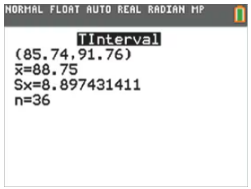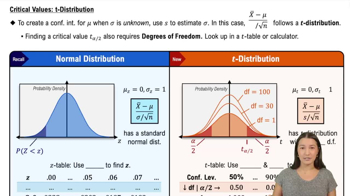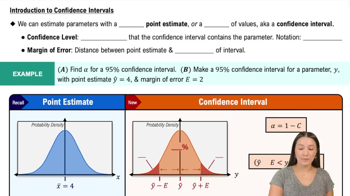Requirements A construction quality control analyst has collected a random sample of six concrete road barriers, and she plans to weigh each of them and construct a 95% confidence interval estimate of the mean weight of all such barriers. What requirements must be satisfied in order to construct the confidence interval with the method from Section 7-2 that uses the t distribution?
Table of contents
- 1. Intro to Stats and Collecting Data1h 14m
- 2. Describing Data with Tables and Graphs1h 55m
- 3. Describing Data Numerically2h 5m
- 4. Probability2h 16m
- 5. Binomial Distribution & Discrete Random Variables3h 6m
- 6. Normal Distribution and Continuous Random Variables2h 11m
- 7. Sampling Distributions & Confidence Intervals: Mean3h 23m
- Sampling Distribution of the Sample Mean and Central Limit Theorem19m
- Distribution of Sample Mean - Excel23m
- Introduction to Confidence Intervals15m
- Confidence Intervals for Population Mean1h 18m
- Determining the Minimum Sample Size Required12m
- Finding Probabilities and T Critical Values - Excel28m
- Confidence Intervals for Population Means - Excel25m
- 8. Sampling Distributions & Confidence Intervals: Proportion1h 12m
- 9. Hypothesis Testing for One Sample3h 29m
- 10. Hypothesis Testing for Two Samples4h 50m
- Two Proportions1h 13m
- Two Proportions Hypothesis Test - Excel28m
- Two Means - Unknown, Unequal Variance1h 3m
- Two Means - Unknown Variances Hypothesis Test - Excel12m
- Two Means - Unknown, Equal Variance15m
- Two Means - Unknown, Equal Variances Hypothesis Test - Excel9m
- Two Means - Known Variance12m
- Two Means - Sigma Known Hypothesis Test - Excel21m
- Two Means - Matched Pairs (Dependent Samples)42m
- Matched Pairs Hypothesis Test - Excel12m
- 11. Correlation1h 6m
- 12. Regression1h 50m
- 13. Chi-Square Tests & Goodness of Fit1h 57m
- 14. ANOVA1h 57m
7. Sampling Distributions & Confidence Intervals: Mean
Confidence Intervals for Population Mean
Problem 2a
Textbook Question
In Exercises 1–4, refer to the accompanying screen display that results from a simple random sample of times (minutes) between eruptions of the Old Faithful geyser. The confidence level of 95% was used.

Degrees of Freedom
a. What is the number of degrees of freedom that should be used for finding the critical value ta/2?
 Verified step by step guidance
Verified step by step guidance1
Step 1: Understand the concept of degrees of freedom (df). In the context of a t-distribution, degrees of freedom are calculated as the sample size (n) minus 1. This is because the t-distribution accounts for variability in the sample mean estimation.
Step 2: Identify the sample size (n) from the screen display. From the image provided, the sample size is given as n = 36.
Step 3: Apply the formula for degrees of freedom: df = n - 1. Substitute the value of n into the formula.
Step 4: Use the degrees of freedom (df) to find the critical value tα/2 for a 95% confidence level. This involves consulting a t-distribution table or using statistical software.
Step 5: Note that the critical value tα/2 depends on the degrees of freedom and the confidence level. For a 95% confidence level, the area in each tail of the t-distribution is α/2 = 0.025.
 Verified video answer for a similar problem:
Verified video answer for a similar problem:This video solution was recommended by our tutors as helpful for the problem above
Video duration:
1mPlay a video:
Was this helpful?
Key Concepts
Here are the essential concepts you must grasp in order to answer the question correctly.
Degrees of Freedom
Degrees of freedom (df) refer to the number of independent values or quantities that can vary in an analysis without violating any constraints. In the context of estimating population parameters, df is typically calculated as the sample size minus one (n - 1). This concept is crucial for determining the appropriate critical value from the t-distribution when constructing confidence intervals or conducting hypothesis tests.
Recommended video:

Critical Values: t-Distribution
Critical Value
The critical value is a point on the scale of the test statistic that separates the region where the null hypothesis is rejected from the region where it is not rejected. For a t-distribution, the critical value is determined based on the desired confidence level and the degrees of freedom. In this case, with a 95% confidence level, the critical value will help define the margin of error for the confidence interval around the sample mean.
Recommended video:

Critical Values: t-Distribution
Confidence Interval
A confidence interval is a range of values, derived from a sample, that is likely to contain the population parameter with a specified level of confidence. It is calculated using the sample mean, the critical value, and the standard error. In the provided example, the confidence interval for the mean time between eruptions of the Old Faithful geyser is given as (85.74, 91.76), indicating that we can be 95% confident that the true mean lies within this range.
Recommended video:

Introduction to Confidence Intervals

 4:48m
4:48mWatch next
Master Population Standard Deviation Known with a bite sized video explanation from Patrick
Start learningRelated Videos
Related Practice
Textbook Question
